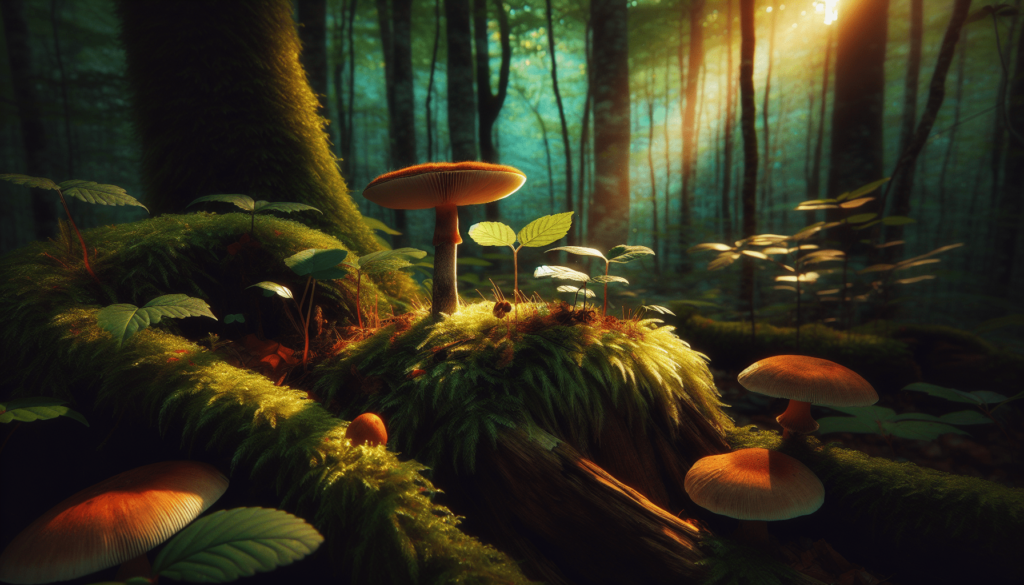Embark on a captivating journey through the enchanting world of mushroom foraging in the Blue Ridge Mountains. Delve deep into the lush forests and rolling hills of this stunning region, where a comprehensive guide awaits you. Discover the best times of year to uncover a plethora of mushroom species, while gaining insights into the unique ecological conditions that contribute to their abundance. With a strong emphasis on safety and responsible foraging practices, you’ll learn how to identify and harvest mushrooms while respecting wildlife habitats. Equip yourself with essential foraging techniques and tools, and explore the culinary and medicinal uses of these fascinating fungi. Immerse yourself in the vibrant community and culture of mushroom foragers, while understanding the importance of conservation and sustainable practices. Engaging narratives and personal stories from experienced foragers will transport you to this magical world, inspiring you to embark on your own foraging adventures with curiosity and wonder.
Introduction to the Blue Ridge Mountains
The Blue Ridge Mountains, located in the eastern part of the United States, is a picturesque and vibrant region known for its breathtaking landscapes, diverse flora and fauna, and rich biodiversity. Stretching from southern Pennsylvania to northern Georgia, this magnificent mountain range offers a plethora of outdoor activities for nature enthusiasts. One such activity that has gained popularity in recent years is mushroom foraging.
Geographical Overview
The Blue Ridge Mountains, part of the larger Appalachian Mountains, span across multiple states, including Virginia, North Carolina, Tennessee, and Georgia. With its rolling hills, dense forests, and ample water sources, the region provides an ideal habitat for a wide variety of mushrooms. The unique geological characteristics, such as the acidic soil and ample rainfall, contribute to the growth of numerous fungal species.
Climate and Ecology
The climate of the Blue Ridge Mountains is characterized by mild winters and moderate summers, creating a diverse ecosystem that supports an abundance of plant and animal life. The dense forests, consisting of hardwood trees such as oak, hickory, and maple, provide the perfect environment for mushrooms to thrive. The region’s biodiversity and ecological balance make it a haven for mushroom enthusiasts, as they can explore a wide range of mushroom species throughout the year.
Popular Mushroom Species in the Blue Ridge Mountains
When it comes to mushroom foraging in the Blue Ridge Mountains, there is a diverse array of species waiting to be discovered. From culinary delights to medicinal treasures, the region boasts an abundance of mushroom varieties. Here are some of the most popular mushroom species found in the Blue Ridge Mountains:
Chanterelles
Chanterelles are highly sought after by mushroom enthusiasts for their delicious flavor and vibrant golden color. These mushrooms have a distinct funnel shape with ridges on the underside, making them easy to identify. Chanterelles are known for their fruity aroma and can be found in the Blue Ridge Mountains from late spring to early fall. They are commonly used in gourmet dishes and add a delightful taste to soups, sauces, and pasta dishes.
Morels
Morels are a favorite among foragers due to their unique appearance and rich, earthy flavor. These mushrooms are known for their distinctive honeycomb-like cap and can be found in the Blue Ridge Mountains in early spring. Morels prefer wooded areas with moist soil, so they are often found near streams and riverbanks. These prized mushrooms are highly versatile and are often used in gourmet cooking, adding a touch of elegance to dishes like risottos, omelets, and sautés.
Chicken of the Woods
Chicken of the Woods, also known as sulphur shelf, is a brightly colored mushroom with shades of orange and yellow. It has a layered, shelf-like appearance and can be found growing on dead or decaying trees in the Blue Ridge Mountains. This mushroom gets its name from its meaty texture and chicken-like flavor. Chicken of the Woods is a popular choice for vegetarian dishes, as it can be used as a substitute for meat in stir-fries, stews, and sandwiches.
Reishi Mushrooms
Reishi mushrooms, also known as the “mushroom of immortality,” have a long history of medicinal use in traditional Chinese and Japanese medicine. These mushrooms have a distinctive kidney-shaped cap with a glossy, reddish-brown color. Reishi mushrooms can be found growing on hardwood trees in the Blue Ridge Mountains throughout the year. They are revered for their immune-boosting properties and are often used in teas, tinctures, and extracts.

Foraging Seasons in the Blue Ridge Mountains
To make the most of your mushroom foraging experience in the Blue Ridge Mountains, it is important to understand the different foraging seasons. Each season offers a unique selection of mushroom species, providing ample opportunities for mushroom enthusiasts to explore and discover new varieties. Here is a breakdown of the foraging seasons in the Blue Ridge Mountains:
Spring Foraging
Spring is an exciting time for mushroom foragers in the Blue Ridge Mountains. As the temperatures begin to rise and the days get longer, a variety of mushroom species start to emerge. Morels are the highlight of the spring foraging season, with their elusive and highly coveted presence in the forest. Other species that can be found during this time include the delicate Oyster mushrooms and the vibrant Yellow Morels.
Summer Foraging
As summer arrives in the Blue Ridge Mountains, the forest floor comes alive with a whole new array of mushrooms. Chanterelles are one of the star attractions during the summer foraging season, with their distinct appearance and fruity aroma. Other species that can be found include the beautiful and delicate Coral mushrooms and the flavorful Black Trumpets.
Fall Foraging
Fall is a bountiful season for mushroom foragers in the Blue Ridge Mountains. The cooler temperatures and increased moisture create the perfect conditions for mushrooms to flourish. This is the time when the highly sought-after Hen of the Woods mushrooms make their appearance, along with a variety of other species such as Puffballs, Porcini mushrooms, and Hedgehogs.
Winter Foraging
While winter may seem like a quiet time for foraging, the Blue Ridge Mountains still offer unique opportunities for mushroom enthusiasts. Certain species, like the Velvet Foot mushrooms, can be found during the colder months. Additionally, foragers can also come across late fruiting species from the previous season, such as the Wood Ear mushrooms and the Turkey Tail mushrooms.
Foraging Locations in the Blue Ridge Mountains
The Blue Ridge Mountains are home to numerous foraging spots, ranging from national forests to state parks and private properties. These locations offer diverse landscapes and ecosystems, providing ample opportunities for mushroom enthusiasts to explore and discover a wide variety of mushroom species. Here are some of the top foraging locations in the Blue Ridge Mountains:
National Forests
The national forests in the Blue Ridge Mountains are treasure troves for mushroom foragers. Pisgah National Forest in North Carolina and George Washington and Jefferson National Forests in Virginia are especially popular among foragers due to their vast expanses of old-growth forests and diverse mushroom populations. These forests offer countless trails and hiking opportunities, allowing foragers to immerse themselves in nature and explore the hidden gems of the mushroom world.
State Parks
State parks in the Blue Ridge Mountains also provide excellent foraging opportunities. Shenandoah National Park in Virginia and Smoky Mountains National Park in Tennessee are two prime destinations for mushroom enthusiasts. These parks not only offer breathtaking scenery and abundant wildlife but also boast diverse mushroom habitats, ranging from the forest floor to fallen logs and trees. Exploring these parks with proper permits and following park regulations can lead to remarkable mushroom discoveries.
Private Properties
In addition to public lands, private properties in the Blue Ridge Mountains can also be fruitful foraging locations. With the permission of landowners, foragers can gain access to unique habitats and discover hidden mushroom treasures. It is important to obtain proper permission and respect the landowners’ property, leaving no trace and ensuring the sustainability of mushroom populations.

Foraging Techniques and Tips
Foraging for mushrooms can be an exhilarating and rewarding experience, but it is essential to approach it with the right techniques and knowledge. Whether you are a beginner or an experienced forager, understanding how to identify edible mushrooms, avoid toxic or inedible species, and properly harvest mushrooms is crucial. Here are some techniques and tips to enhance your mushroom foraging journey in the Blue Ridge Mountains:
Identifying Edible Mushrooms
Accurately identifying edible mushrooms is one of the most critical skills for mushroom foragers. It is essential to know the distinguishing features of different mushroom species, such as cap shape, color, stem characteristics, and spore print colors. Consulting field guides, attending mycology workshops or classes, and joining local mycology organizations can help you develop a solid understanding of mushroom identification. Additionally, connecting with experienced foragers who can guide and mentor you in the field can greatly enhance your ability to identify edible mushrooms.
Avoiding Toxic or Inedible Species
While the Blue Ridge Mountains are home to many edible mushroom species, there are also toxic and inedible mushrooms that should be avoided. It is crucial to familiarize yourself with the poisonous species in the region and learn how to differentiate them from edible varieties. Some toxic mushrooms in the Blue Ridge Mountains include the Deadly Galerina, the Destroying Angel, and the Death Cap. If in doubt, it is best to err on the side of caution and avoid consuming any mushroom that you cannot confidently identify as edible.
Harvesting Methods
When it comes to harvesting mushrooms in the Blue Ridge Mountains, it is important to adopt sustainable practices that ensure the long-term health of mushroom populations and protect their habitats. Here are some guidelines for responsible mushroom harvesting:
- Harvest selectively: Only pick mature mushrooms, leaving the young ones to grow and disperse spores for future generations.
- Use a knife: Instead of pulling mushrooms out of the ground, use a sharp knife to cleanly cut the stem near the ground. This reduces soil disturbance and allows for the regeneration of the mycelium.
- Be gentle: Handle mushrooms with care to avoid damaging the delicate structures and spore-bearing surfaces.
- Leave no trace: Clean up any debris or litter left behind and leave the foraging area as you found it. This includes filling in any holes created in the search for mushrooms.
By following these harvesting methods, foragers can enjoy a sustainable and responsible foraging experience that contributes to the preservation of mushroom ecosystems.
Tools and Equipment for Mushroom Foraging
Having the right tools and equipment can greatly enhance your mushroom foraging experience in the Blue Ridge Mountains. Here are some essential items to consider:
Foraging Baskets
A foraging basket is a must-have tool for any mushroom enthusiast. Choose a basket with an open weave or mesh design that allows spores to fall through as you collect mushrooms. This helps in dispersing the spores and promotes the growth of new mushrooms in the area. Additionally, a basket with a sturdy handle and ample space will ensure that you can collect a significant quantity of mushrooms without damaging them.
Knife and Brush
A sharp knife is a valuable tool for cleanly cutting mushrooms from their stems. Choose a knife with a thin, curved blade that allows for precise cuts. A brush, such as a soft-bristled pastry brush or a mushroom-specific brush, is useful for removing any dirt or debris from the mushroom caps without damaging the delicate structures.
Field Guide or Smartphone Apps
Carrying a field guide or using smartphone apps dedicated to mushroom identification can be incredibly helpful while foraging. Field guides provide detailed descriptions, photographs, and identification keys for different mushroom species, allowing you to confidently identify mushrooms in the field. Smartphone apps, such as iNaturalist or Mushroom ID, provide a convenient and interactive way to identify mushrooms using your phone’s camera or by manually entering characteristics.
By equipping yourself with these tools and resources, you can navigate the Blue Ridge Mountains with confidence, identify mushrooms accurately, and make the most of your foraging experience.

Culinary Delights: Cooking with Blue Ridge Mountain Mushrooms
One of the greatest joys of mushroom foraging in the Blue Ridge Mountains is bringing your edible treasures into the kitchen and transforming them into delicious culinary creations. The region’s diverse mushroom species offer a wide range of flavors and textures, allowing for endless culinary possibilities. Here are some ways to cook and enjoy Blue Ridge Mountain mushrooms:
Local Recipes
Exploring local recipes is a fantastic way to celebrate the unique flavors and culinary traditions of the Blue Ridge Mountains. The region’s cuisine often incorporates mushrooms into hearty stews, savory pies, and comforting soups. From classic Appalachian morel bisques to mushroom and wild rice casserole, there are countless recipes that showcase the delicious flavors of Blue Ridge Mountain mushrooms.
Traditional Uses
Mushrooms have been an integral part of traditional cuisines in various cultures for centuries. Understanding how different cultures use mushrooms can inspire you to experiment with new flavors and cooking techniques. For example, in Chinese cuisine, mushrooms like Shiitake and Wood Ear are commonly used in stir-fries and soups, while European cuisines feature mushrooms in dishes like risottos, mushroom sauces, and stuffed mushrooms.
Gourmet Mushroom Dishes
Blue Ridge Mountain mushrooms are highly valued in gourmet cooking due to their unique flavors and textures. From the delicate and nutty Chanterelles to the meaty Hen of the Woods, these mushrooms can elevate any dish to a gourmet level. Consider sautéing Chanterelles with garlic and thyme as a side dish, or using Hen of the Woods mushrooms as a filling for savory tarts. The possibilities are endless, and the flavors are sure to impress.
Experimenting with different cooking techniques and flavors allows you to fully appreciate the culinary potential of Blue Ridge Mountain mushrooms. So get creative, try new recipes, and savor the delightful flavors that nature has to offer.
Medicinal and Therapeutic Uses of Blue Ridge Mountain Fungi
Beyond their culinary uses, mushrooms found in the Blue Ridge Mountains have a long history of being used for their medicinal and therapeutic properties. Traditional healing systems in various cultures have recognized the health benefits of mushrooms, and modern research continues to unveil their potential. Here are some ways Blue Ridge Mountain mushrooms are used for their medicinal properties:
Traditional Healing
Traditional Chinese and Japanese medicine have extensively utilized mushrooms for their healing properties. Reishi mushrooms, for example, have been revered for centuries for their immune-boosting and stress-relieving capabilities. They are often consumed in the form of teas, tinctures, or extracts to support overall well-being. Other mushrooms, such as Lion’s Mane and Cordyceps, are also traditionally used for their various health benefits, including cognitive support and energy enhancement.
Modern Medicinal Applications
Modern scientific research has shed light on the vast potential of Blue Ridge Mountain mushrooms for various health conditions. For example, Turkey Tail mushrooms have been extensively studied for their immune-enhancing properties and are even used as an adjunct therapy in cancer treatment. Lion’s Mane mushrooms have shown promise in supporting brain health and cognitive function. Chaga mushrooms are rich in antioxidants and are believed to have anti-inflammatory and immune-modulating effects.
It is important to note that while mushrooms can offer potential health benefits, it is essential to consult with a healthcare professional before incorporating them into your wellness routine. They should not be used as a substitute for medical advice or prescribed treatments.

Community and Foraging Groups in the Blue Ridge Mountains
Mushroom foraging is not only a solitary activity but also a way to connect with like-minded individuals and become part of a vibrant community. The Blue Ridge Mountains offer a range of opportunities for mushroom enthusiasts to engage with others who share their passion. Here are some community and foraging groups you can connect with:
Mycology Workshops and Classes
Attending mycology workshops and classes can provide valuable knowledge and hands-on experience for mushroom enthusiasts. These educational events are often led by experienced foragers, mycologists, and experts who share their wisdom and guide participants in mushroom identification, foraging techniques, and cooking tips. By participating in these workshops, you can expand your understanding of mushrooms and forge connections with fellow enthusiasts.
Foraging Festivals
Foraging festivals are popular events that bring together mushroom enthusiasts from near and far. These festivals often feature guided forays, educational talks, cooking demonstrations, and opportunities to taste a variety of mushrooms. The Blue Ridge Mountains are home to several foraging festivals throughout the year, where you can immerse yourself in the world of mushrooms and celebrate the bounties of nature.
Local Organizations
Various local organizations in the Blue Ridge Mountains are dedicated to promoting the study and appreciation of mushrooms. These organizations often host regular meetings, forays, and other events that provide opportunities to connect with fellow enthusiasts, learn from experienced members, and contribute to ongoing research and conservation efforts. Joining local organizations allows you to become part of a passionate community and actively contribute to the preservation and understanding of mushrooms.
Engaging with the mushroom foraging community in the Blue Ridge Mountains can enrich your experience, provide valuable mentorship, and broaden your knowledge. It is through these connections that you can truly appreciate the wonders of the mushroom world.
Conservation and Sustainable Foraging Practices
As mushroom foraging gains popularity, it is crucial to prioritize conservation and sustainable practices to protect mushroom ecosystems and ensure the longevity of mushroom populations in the Blue Ridge Mountains. Here are some reasons why conservation is important and ways to forage responsibly:
Importance of Conservation
Mushrooms play a vital role in ecosystem health and function. They aid in nutrient cycling, break down organic matter, and form symbiotic relationships with plants. By foraging responsibly and conserving mushroom habitats, we can help maintain the delicate balance of these ecosystems and protect the biodiversity of the Blue Ridge Mountains.
Leave No Trace Foraging
Leave No Trace foraging is a principle that emphasizes minimizing your impact while foraging. It involves practices such as:
- Staying on designated trails and avoiding trampling vegetation.
- Harvesting selectively and leaving enough mushrooms behind for wildlife and future growth.
- Avoiding damage to surrounding vegetation and soil.
- Properly disposing of any litter and packaging brought into the foraging area.
- Adhering to any regulations or restrictions specific to the foraging location.
By following these principles, foragers can enjoy the abundance of the Blue Ridge Mountain mushrooms while ensuring the preservation of natural habitats.
Responsible Harvesting
Responsible mushroom harvesting goes beyond the Leave No Trace principle and involves sustainable practices that promote the regeneration and health of mushroom populations. Some tips for responsible harvesting include:
- Harvesting mature mushrooms and leaving young ones to disperse spores.
- Cutting mushrooms cleanly with a knife to minimize damage to the mycelium and surrounding vegetation.
- Avoiding over-harvesting in a particular area to allow for the natural regeneration of mushrooms.
- Spreading out your harvest location to disperse the impact on the mushroom ecosystem.
- Sharing your knowledge and passion for conservation with fellow foragers, promoting awareness and ethical practices within the community.
By adopting responsible harvesting techniques, foragers can enjoy the bounty of the Blue Ridge Mountains while ensuring the sustainability of mushroom populations for future generations.
In conclusion, the Blue Ridge Mountains offer a spectacular backdrop for mushroom foraging, from its diverse mushroom species to its breathtaking landscapes. By understanding the geographical overview, climate, and ecology of the region, as well as the popular mushroom species and foraging seasons, you can embark on a rewarding and enriching foraging journey. Exploring the various foraging locations, mastering identification techniques, and utilizing the right tools and equipment will enhance your experience and increase your chances of discovering unique mushroom species. Furthermore, learning how to cook and appreciate Blue Ridge Mountain mushrooms, understanding their medicinal uses, and engaging with the mushroom foraging community will provide a holistic and fulfilling foraging experience. Finally, prioritizing conservation and sustainable practices will ensure the preservation and longevity of mushroom ecosystems in the Blue Ridge Mountains for generations to come. So, grab your basket, put on your hiking boots, and delve into the magical world of mushroom foraging in the Blue Ridge Mountains. Happy foraging!

